 | Nikola Bašić is the author of probably the most beautiful monument dedicated to the Sun that exists on the Earth. The monument is placed in the city of Zadar, on the Croatian coast, along with equally famous Zadar Sea Organ. This is one of greatest achievements of contemporary Croatian Art and Architecture. |

| Nikola Bašić is the author of probably the most beautiful monument dedicated to the Sun that exists on the Earth: Monument to The SunThe monument is placed in the city of Zadar, on the Croatian coast, along with equaly famous Zadar Sea Organ. This is one of greatest achievements of contemporary Croatian Art and Architecutre. |
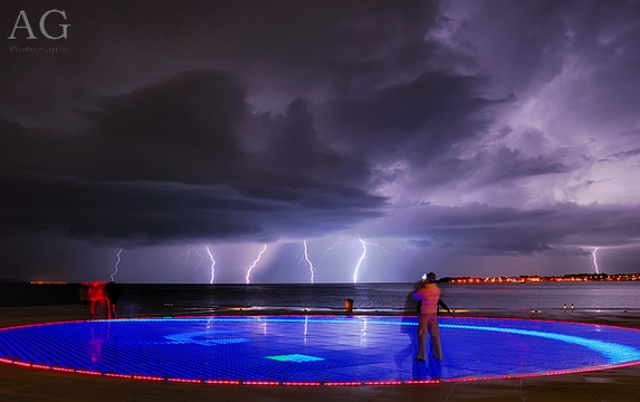
Photo by Aleksandar Gospić, March 2008, source www.ezadar.hr
| Spomenik suncu Simbolička urbana instalacija koja, posredstvom fotonaponskih ćelija ugrađenih u obalnu šetnicu, sunčevu energiju pretvara u svjetlosni spektakl. | Monument to the Sun Symbolic urban installation which, by means of photovoltaic cells built-in sea walkway, changes solar energy into lighting spectacle. |
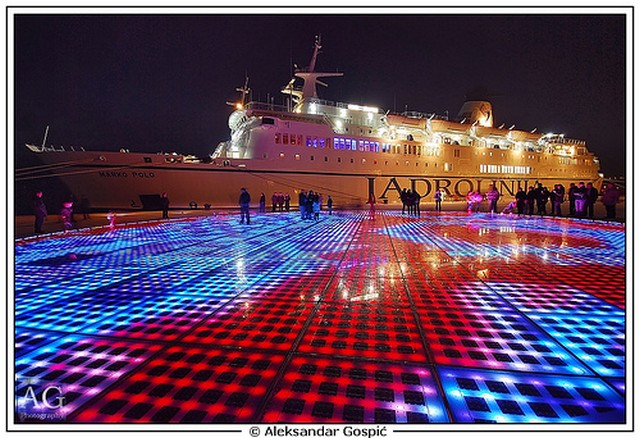
Photo by Aleksandar Gospić, source flickr.com/photos/trancevelebit/
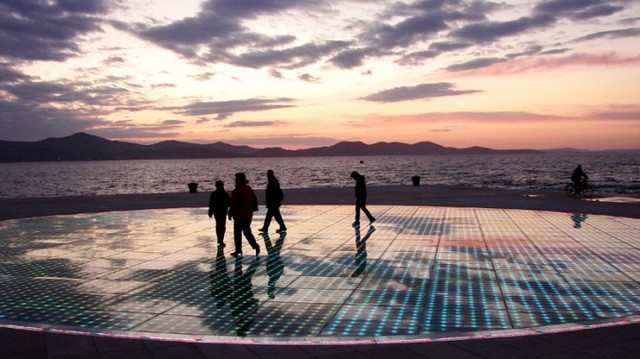
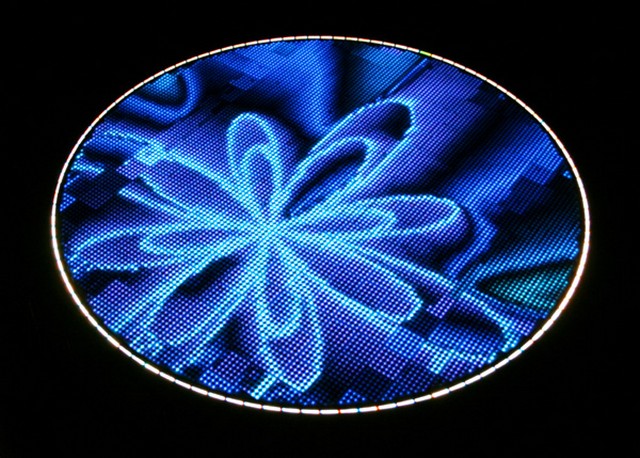

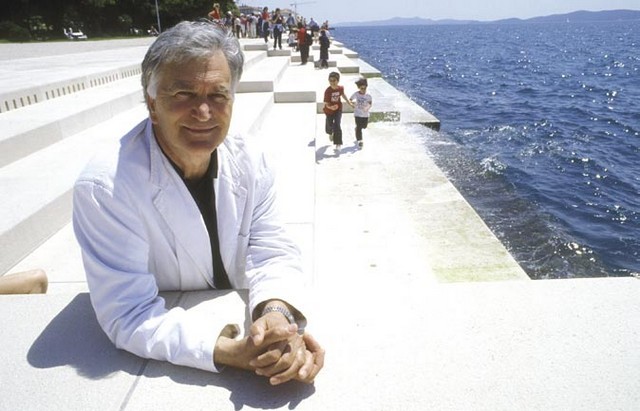
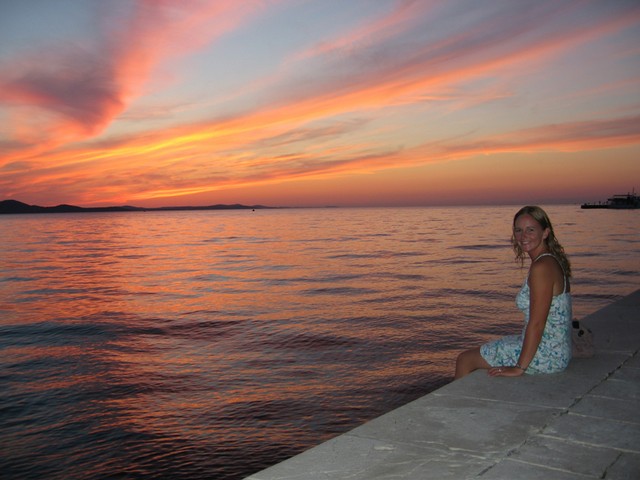
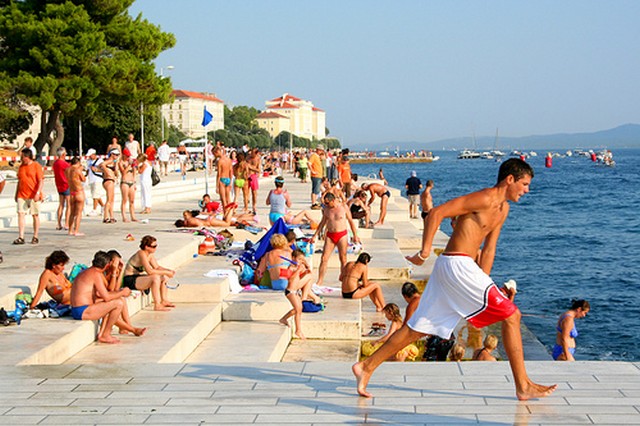
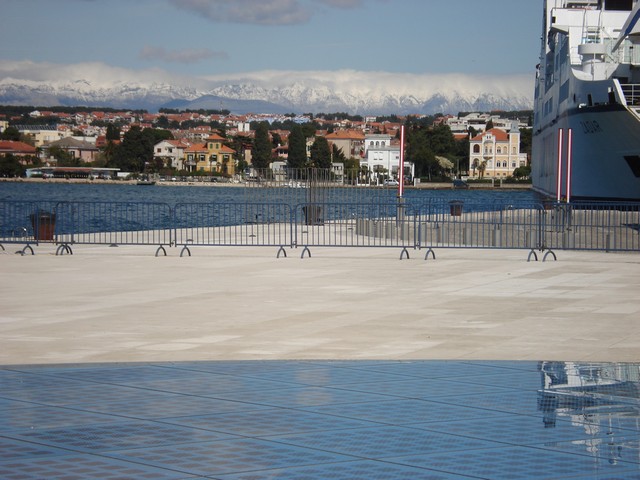
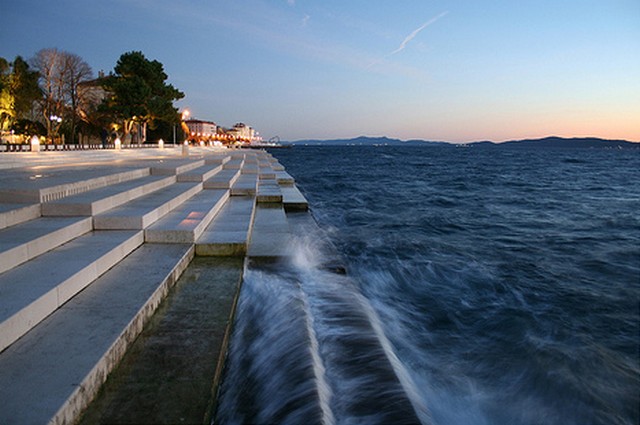
The Zadar Sea Organ, an attraction just a few meters from the Monument to the Sun.
1) How did the idea for the sea organ come to you? Many believe that the sea organ was designed following the project task made according to the investor wishes. That was, certainly, not the case. My task was, in fact, to reshape the promontory of the Zadar peninsula with its historic part, in order do build the seafront adequate for large cruisers, wishing to visit Zadar A part of this seafront contained also a promenade, very dear to the Zadar citiziens, but due to its small depth not in operative function. It used to be neglected,very dark and deserted in the part where the sea organ is located today. That was the reason for my decision to revitalize this space by providing it with an interesting urban attraction. At the start, I was not sure of the final solution but I proposed to turn the usual seafront,70m long, into a strong staircase which would give access to the sea. I wanted to make people come into contact with the sea. I wanted to invite them to communicate with the nature. In explaining and defending this intention to the client, I emphasized the change in the sound that the change in the cross section would provoke. I was completely taken by that idea. I became aware that on the global line dividing the two media, the sea and the land, the one that shapes the islands and the continents, the clash of these two media had always been resolved by sound. How much this inevitable encounter could be poetic but also dramatic was close to me because of my childhood spent on an island. I was aware that sound gives and additional dimension to every coastal space, a dimension of the spatial sound or the acoustic space. At that moment I realized what my task should really be. A final result was achieved with professional help of hydraulic engineer, acoustic engineer and the organ master. 2) Why it represents a good symbol for Zadar? Zadar is percieved through this project as a town aspiring to create new contemporary urban values, the witnesses of ourselves and our present in some future times. 3) To me it seems that having something that is beautiful but is - for the most part - invisible is a great monument for a town with tradional architecture and many opinions of what should and should not be there. What do you think? Instead of the reconstruction of the urban structures lost during the war or even of a greater danger of vulgar commercialization I tried to rethink this space without any usual contents like shops, coffee-shops and their terraces. A town is a chest of metaphoric places shaping its mental picture, a kaleidoscope in whose mosaic structure not only its identity is recognized, but also collective and individual identification with the town. Such metaphors we inherited, in general, as historical heritage but very seldom we come across the urban metaphors created in our times. Are we at all capable of shaping these new places of our urbanity, especially those that could emotionally touch us and with which we could intimately identify? How to create new places of strong character to which we would like to return? We live in the time of total communication but we are oblivious of the communication with something that is by fate defining us- the nature. I realized that the Zadar seafront – in fact a promenade, which used to be boring in its linearity, should be spatially made dramatic. I was convinced that it is exactly that spatial scenario derived from the communication with nature that could represent a strong point in the shaping of the urban points of expressive quality. Zadar touristic marketing often starts with the story of Hitchock fascination with its sunset. Namely, during his stay in Zadar in the 1960s he pronounced it the most beautiful sunset in the world. This was the beginning of the idea of an installation, later to be named the monument to the sun. The seafront staircase designed to improve the communication with the sea was turned into the sea organ. In this way two places of great expressive character were created making them recognizable symbols of Zadar on a global scale. 4) Does Zadar make a good place for progressive ideas? Please explain. I believe that Zadar is a town receptive for many progressive ideas, being a very open town at least in comparison to other Dalmatian cities. 5) How has the attention for the Sea Organ been good for Zadar? The Sea Organ was acclaimed globally resulting in global promotion of our city. 6) Can you explain, briefly how the organ works? The sea organ is designed in form of stairs stimulating in this way the change in the walk along the seafront and resulting in people stopping and descending the stairs to the sea. The stone staircase is divided into seven 10m sections containing underneath polyerethene tubes of different diameters.The air is pushed by the waves from the larger into thinner tubes,then accelerated and finally producing sound in the pipes placed in the resonant corridor under the promenade, from where the sound comes out into the space through mystic apertures. In the same way the sea energy is inpredictable in the innumerous changes of high and low tide, in the change of the size, strength and direction of the waves, so is this aeternal concert unrepeatable in it music variations, whose author and interpreter is the nature itself. 7) How is the city changing? With the sea organ the new seafront (Nova riva) has literally changed its character and has become a scene of new urban sociability and a sign of new urban identity. Our town has always been a place of great demographic changes. The places ¸we are mentining are like an urban retort with the Ťchemistryť of loyalty and love for the town taking place inside it. They produce urban cohesion and provoke a sense of community and solidarity, everything that stands for identification with a certain place. This could result in the flow of energy emanating from a town, a very important element in the perceiving of the life quality but also for its future development. 8) What is the basic thing that makes Zadar Zadar? How could you define the city? Zadar is defined as Zadar by its historic core, its heart that has always been the heart of its region. Zadar has a very vital continental hinterland but also the densest string of islands in the Mediterrenean. This is where the city strength lies. 9) When speaking to dr. Kolega it came to my mind that Zadar is a place that could forsee the future by digging up the past... literally. Does that seem true to you? Or is its past be always a priority for Zadar? In his long history Zadar was often destroyed and then rebuilt. That is the reason why this town is like a palimpsest- an old parchment with old inscriptions being erased and new ones inscribed. But the old ones are always perceivable. In the same way the old historic structure is visible in many places. But even there where it is invisible, like in palimpsest metaphor, we know that it had existed. Its spiritual force is erupting from the soil and imprinting our soles. This idea is fascinating. We could also use another metaphor. Zadar a city built from archeological fragments. Its contemporary structure is made from the fragmnents of all the previous Zadar settlements. Zadar was like a delicate broken vase after the greatest destruction during the WW2. At the time some were convinced that the best thing to do would be to gather the broken pieces, put them back into their original place and glue them together. Luckily that was not what happened. The use of the archeological remnants is characteristic for the Zadar building heritage. These are the parts(mainly stone ones) from the demolished buildings that were later incorporated into new structures. In this way a most marvellous Croatian temple and a symbol of Zadar was constructed from the remnants from the Roman Forum- the St.Dunat church. In the same manner Zadar was renovated after the catastophic destruction of 1944. The fragments were not put in their previous places but they were used as material to make new forms. That is why Zadar posseses that marvellous and spontaneous mosaic structure. This mosaic and layered urban structure should be also in the future carefully assembled and filled up. 10) How is Zadar "finding" itself and what is its future? Talking of the Zadar development or of development in general we often forget that the development is not synonimous with growth because development stands in the first place for high quality transformation. High quality development of a town is something worth discussing and what should be stressed at all times. The impression of participating in dynamic, urban, cultural and economic environment lies at the base of high quality life in a certain town. In place of a town within a region contemporary Zadar is becoming more and more a regional town. It develops urban nodes on the nearest islands and in the coastal area, so we could talk about a nodal urban network. Contemporary dispersion of production and delocalization of the working place, a process quite contrary to the ideological proletarization and industrialization of the past times, directs us to view Zadar as a very particular urban structure which I like to call urbo-archipelago. I was born in Murter on the island of the same name. The island of Murter lies in a border area of gravitation of two Dalmatian towns: Zadar and Šibenik. The people from Murter go to Šibenik for administrative reasons, but they are connected to Zadar by the life on Kornati islands. Our ancestors, former serfs of the Zadar landed nobility , bought the islands from their masters. So I have a privilege of loving two beautiful and special towns. I finished secondary school in Zadar and went to Sarajevo for the study of architecture. After graduating I stayed for five years at the Faculty and then returned to Zadar and in 1981 started my own practice. As I was sure of my future calling in the high school I was already then with great excitement thinking of how I was going to build new Zadar. Now this dream of mine is becoming a reality. 12) Zadar seems like a place with fresher ideas than any other town on the coast. What makes it different from the rest of Dalmatia (Split and Dubrovnik, for instance)? We, that live and work in Zadar, are not, for most of the time, conscious of the value of these ideas, but I am stressing all the time that it is more important how the others see us than what we think of ourselves. Zadar is perceived as a successful town especially by people from the outside. It is this external perception important for our town because it brings many good vibrations and a display of positive energy. It is our duty to recognize and use this perception in making our town a desirable place for living for those people that would by their qualities enhance its values and potential. I try very hard to contribute by my projects to such perception of Zadar. It is exactly that what is taking place in Zadar that denies the opinions that the chances for a high quality life are present only in a large city. If Zadar is in any way different from the rest of Dalmatia then it is in its openess and good connections with the world. In this, in my opinion, lies its strength. An open mind for new people and new ideas made so many good things happen in Zadar. The connections of Zadar with the world do not come from yesterday. In 1292., in Zadar, St Krševan calendar was made, one of the oldest calendars with solar epheremides and the first in Arabic numerals. This document is kept in Oxford, as some of the Oxford documents are being kept in Zadar. This shows that Zadar was already in the Middle Ages a part of the European science and that the Oxford and Zadar scientific elite was in lively interaction. That was the reason why we inscribed solar ephemerides for that particular geopgraphic point for the days of all the Zadar saints,into a metal ring that separates the glazed floor of the urban installation monument to the sun from the seafront stone pavement. Our wish was to draw attention to that significant piece of the Zadar cultural heritage, but also to establish the relation of the installation location to the sun positions. 13) Please explain the latest Monument to the Sun project. When will it be open and why is it appropriate for Zadar? How does it continue to make the most of the available space? It is a circular glazed surface of 22m diameter, lying in the plane of the seafront pavement, and one can walk on it. It is equipped with photo-voltaic plates, with a grid of light points underneath, consisting in fact of a dispersed display with over 10.000 tiny light bulbs. Each single bulb changes intensity and colour induced by a computer. In fact, this is an installation that could emanate light in all its possible sensations, send messages, form graphemes, write the words. What is most exciting is that one could approach that dynamic light spectacle, that is bringing you into an immaterial environment, physically, with a sensation of swimming or the soil moving under your feet. The project underwent a long journey and was developed through multi-disciplinary cooperation, but the basic idea of communicating with the nature was always present. As in the sea organ we communicate with the nature by help of sound so in this new installation we communicate with nature by help of light. Both installations are leading us to the encounter with nature. This encounter is taking place on a particular spot which is in this way being stronly characterized and becoming an important point of urban interest. These places invite one to a specific contact with nature, which in our crazy way of life we almost do not notice. 14) How will the Monument to the Sun work. Contrary to the sea organ, an almost archaic structure functioning like perpetum mobile, monument to the sun is a very sophisticated installation involving experts from Croatia and some other European countries. It is an urban installation inserted into the seafront stone pavement. It is going, by help of photo-voltaic modules, to exchange energy with the sun and turn it into a light play. It is important to stress that the same energy is to be used for the general illumination of the seafront making the monument to the sun a device for producing energy from alternative sources. This makes it an ecological installation whose implementation is encouraged by EU programme of reducing the emission of noxious gasses. It cannot be proved as yet, but the installation has many possibilities and in the future the story will become more complex and rich by involvment of video-artists who could create light effects, introducing them into thematic programmes to be emitted depending on the occasion. I am personally happy that the organ sound could be turned ino the light. Nevertheless, with the greatest excitement, I am awaiting the possibility of realizing a communication of the pedestrians and the installation. 15) Please, explain fully how the Monument works. By entering the light circle a walker will induce a specific light reaction. One person will induce one reaction, the other person another, ten persons will induce ten cumulative effects. We are going to play with the installation and participate in the creation of light effects in this specific interaction. From the very start I was certain that the ludic approach to the design of the seafront is what I wanted to realize. Civilization is based on play, culture was in its beginning a play, play lies at the basis of every culture. In my installations I wanted to affirm the phenomenon of play as an impulse for social communication and as an impulse for urban culture and specific urban hedonism. Rejoicing in urban space, in the joy of playing, of meetings, of the possibility to get in touch with nature, the pleasure of recognizing certain important and dear places to which we like to return, all this makes stronger our belonging to a town. Speaking of those places with love and boasting of them, we send a message that they belong only to us and to no one else. 16) What makes Zadar a good place for such types of projects (Sea Organ and Monument to the Sun). Many thanks to Mrs. Barbara Stelluti, Zadar, for sending us this interview.
For more information please contact Mrs Barbara Stelluti, Zadar, marina-projekt@zd.t-com.hr
Formated for CROWN by prof.dr. Darko Žubrinić
Distributed by www.Croatia.org . This message is intended for Croatian Associations/Institutions and their Friends in Croatia and in the World. The opinions/articles expressed on this list do not reflect personal opinions of the moderator. If the reader of this message is not the intended recipient, please delete or destroy all copies of this communication and please, let us know!